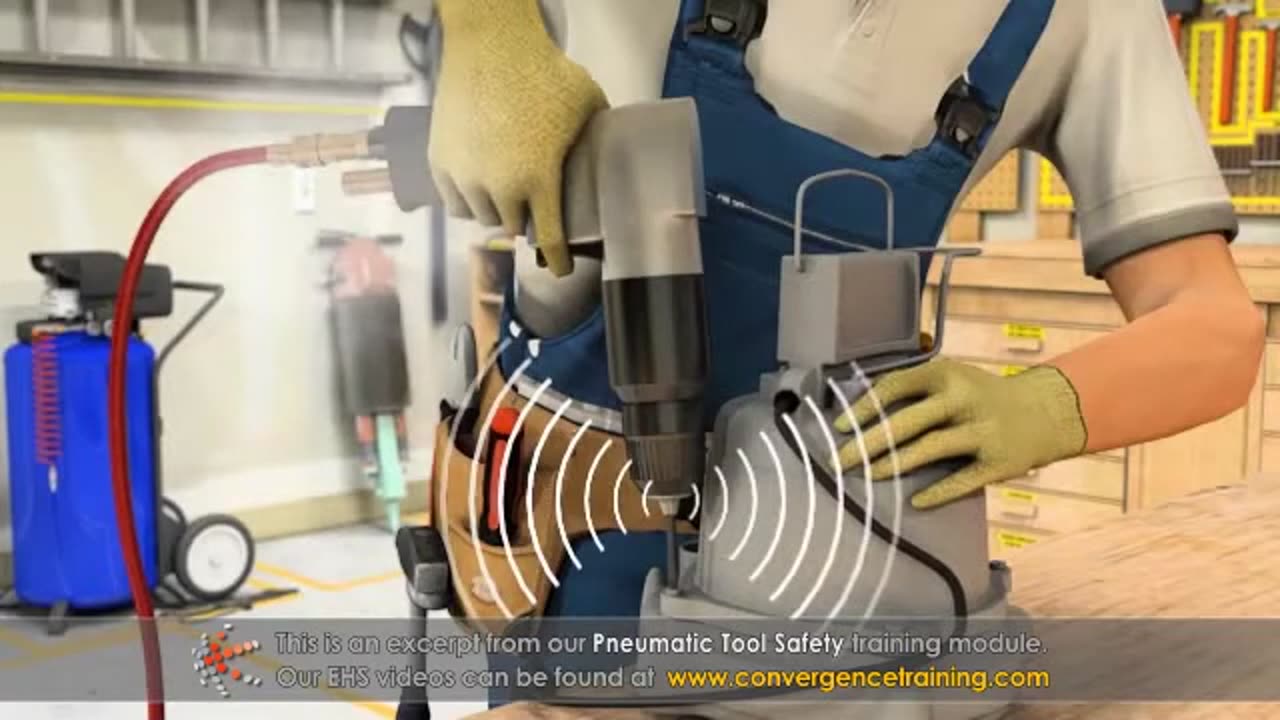Premium Only Content

Pneumatic Tool Safety Training
**Pneumatic Tool Safety Training** is essential to prevent injuries and ensure safe operation of air-powered tools in workplaces like construction sites, factories, and workshops. Below is a comprehensive guide for conducting effective training:
---
### **1. Objectives of the Training**
- Educate users on safe operation, maintenance, and handling of pneumatic tools.
- Reduce risks of injuries caused by improper use or tool malfunctions.
- Promote adherence to workplace safety standards and regulations.
---
### **2. Common Hazards Associated with Pneumatic Tools**
- **Compressed Air Hazards**: High-pressure air can cause serious injuries or be a fire hazard.
- **Flying Debris**: Loose materials can become projectiles.
- **Noise**: High decibel levels can cause hearing damage.
- **Ergonomic Risks**: Repetitive use or poor posture can lead to musculoskeletal injuries.
- **Hose and Fitting Issues**: Damaged hoses can whip violently under pressure.
- **Tool Malfunctions**: Defective tools may misfire or fail.
---
### **3. Personal Protective Equipment (PPE)**
- **Mandatory PPE**:
- Safety goggles or face shields (to protect against debris).
- Hearing protection (earplugs or earmuffs).
- Gloves (cut-resistant and vibration-dampening).
- Steel-toed boots (for dropped tool protection).
- **Optional PPE**:
- Respirators if using tools in dusty or chemical environments.
---
### **4. Safe Operation Practices**
#### **a. Pre-Use Inspections**
- Check the tool and hose for:
- Cracks, wear, or damage.
- Proper connections and fittings.
- Secure and functional guards or safety mechanisms.
- Ensure the pressure regulator is set to the tool's rated pressure.
#### **b. Proper Handling**
- Use both hands to maintain control, especially for larger tools.
- Never point the tool at yourself or others, even if not in use.
- Always disconnect the air supply before servicing, changing accessories, or storing the tool.
#### **c. Safe Connection Practices**
- Use secure, locking couplers to prevent accidental disconnection.
- Depressurize hoses before connecting or disconnecting them.
- Avoid kinks, tangles, or running hoses through high-traffic areas.
#### **d. Usage Guidelines**
- Operate within the manufacturer’s recommended pressure limits.
- Avoid using compressed air to clean clothing or skin.
- Work in well-ventilated areas to prevent fume buildup.
- Use the correct attachments and accessories designed for the specific tool.
#### **e. Safe Storage**
- Store tools in a clean, dry location to prevent rust and contamination.
- Coil hoses properly and away from heat sources or sharp edges.
---
### **5. Maintenance Best Practices**
- Regularly inspect and lubricate tools per manufacturer guidelines.
- Replace worn or damaged parts immediately.
- Ensure hoses are stored without twists or kinks to prolong their life.
- Use only compatible and high-quality parts and fittings.
---
### **6. Emergency Procedures**
- Train employees to:
- Shut off the air supply in emergencies.
- Address hose blowouts safely by releasing pressure.
- Administer first aid for cuts, bruises, or other injuries caused by pneumatic tools.
---
### **7. Specific Training for Tools**
- **Nail Guns**: Avoid using nails in materials that can ricochet; secure materials firmly.
- **Impact Wrenches**: Use proper torque settings to prevent tool strain or damage.
- **Grinders**: Use guards and ensure the grinding wheel is in good condition.
- **Chisels/Drills**: Secure the workpiece and use appropriate bits for the material.
---
### **8. Compliance and Workplace Policies**
- Follow OSHA guidelines (e.g., CFR 1910.242 for pneumatic tools).
- Encourage reporting of unsafe conditions or tool defects.
- Post clear signage about maximum air pressure limits and tool handling protocols.
---
### **9. Hands-On Training**
- Allow workers to practice:
- Connecting and disconnecting hoses safely.
- Adjusting pressure settings.
- Handling tools in simulated or real work environments.
- Use demonstrations to show the effects of improper pressure or tool misuse.
---
### **10. Follow-Up and Refresher Training**
- Schedule periodic reviews to reinforce best practices.
- Incorporate feedback from workers to address specific concerns or incidents.
- Update training materials when new tools or safety standards are introduced.
---
Would you like assistance with creating slides, checklists, or printable safety guides for this training?
-
 7:58
7:58
HSESafetyInformation
7 months agoAuthentic Peshawari Rosh _ Namkeen Gosht Recipe __ Traditional KPK and Baluchistan
701 -
 LIVE
LIVE
Simply Bitcoin
1 hour ago $0.33 earnedLEAKED CONVERSATION: US SECRET Bitcoin Plan EXPOSED?! | EP 1350
264 watching -
 LIVE
LIVE
StoneMountain64
1 hour agoBF6 Full Release Gameplay Review - I have been playing EARLY
93 watching -
 LIVE
LIVE
Barry Cunningham
14 hours agoBREAKING NEWS: PRESIDENT TRUMP HOSTS FULL CABINET MEETING!
1,066 watching -
 LIVE
LIVE
The Charlie Kirk Show
1 hour agoTurning Point Halftime + Antifa Panel Aftermath + Right-Wing Taylor Swift? |Patrick, Cuomo|10.9.2025
6,276 watching -
 4:27:44
4:27:44
Right Side Broadcasting Network
5 hours agoLIVE REPLAY: President Trump Hosts a Cabinet Meeting - 10/9/25
87.2K39 -
 LIVE
LIVE
Mark Kaye
2 hours ago🔴 Schumer BUSTED Celebrating Democrat Shutdown!
1,012 watching -
 1:00:33
1:00:33
Timcast
2 hours agoTrump To Declare Antifa FOREIGN Terrorist Org, Antifa Leaders FLEE Country
120K51 -
 2:41:53
2:41:53
MattMorseTV
3 hours ago $6.53 earned🔴Trump's Cabinet Meeting BOMBSHELL.🔴
40.7K32 -
 DVR
DVR
Neil McCoy-Ward
1 hour ago🔥 SHOCK! What She Just DECLARED Over The 🇺🇸 USA & Trump!
5.17K3
